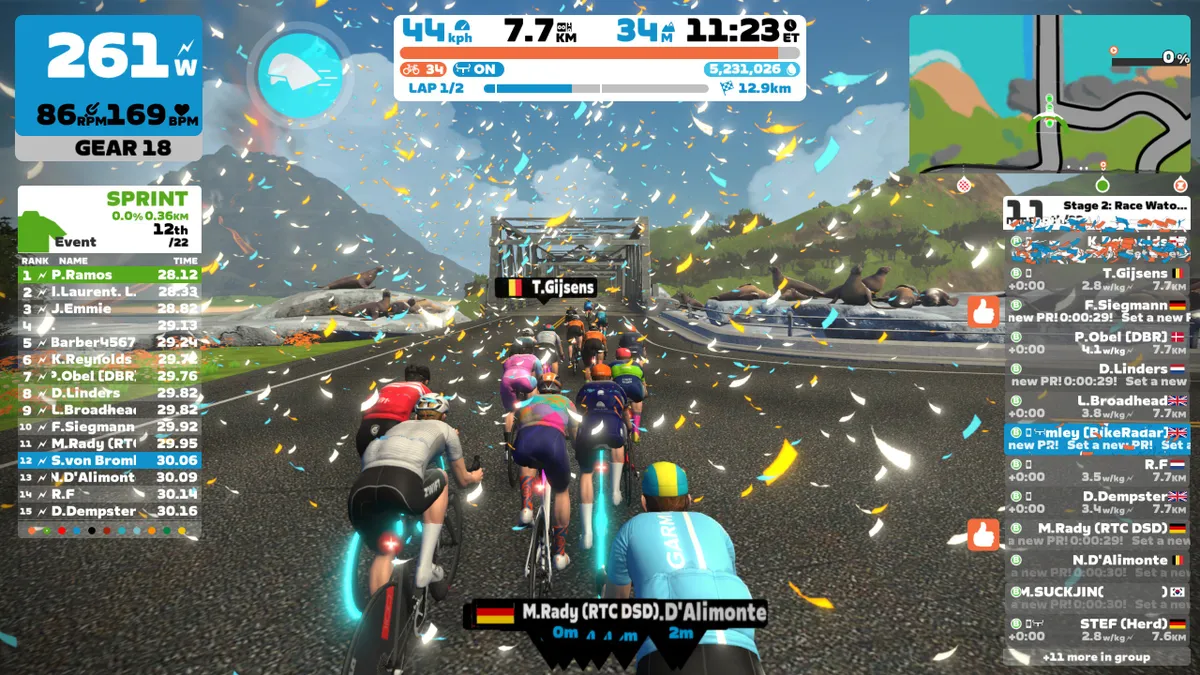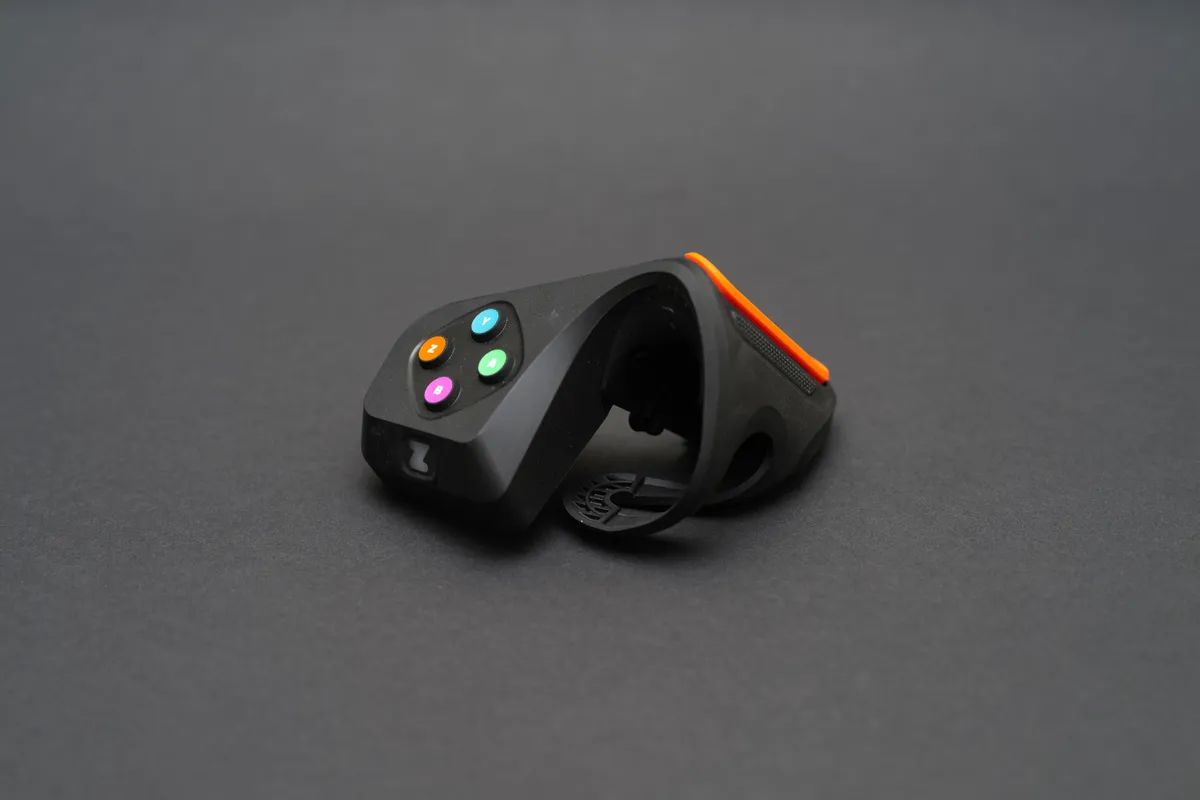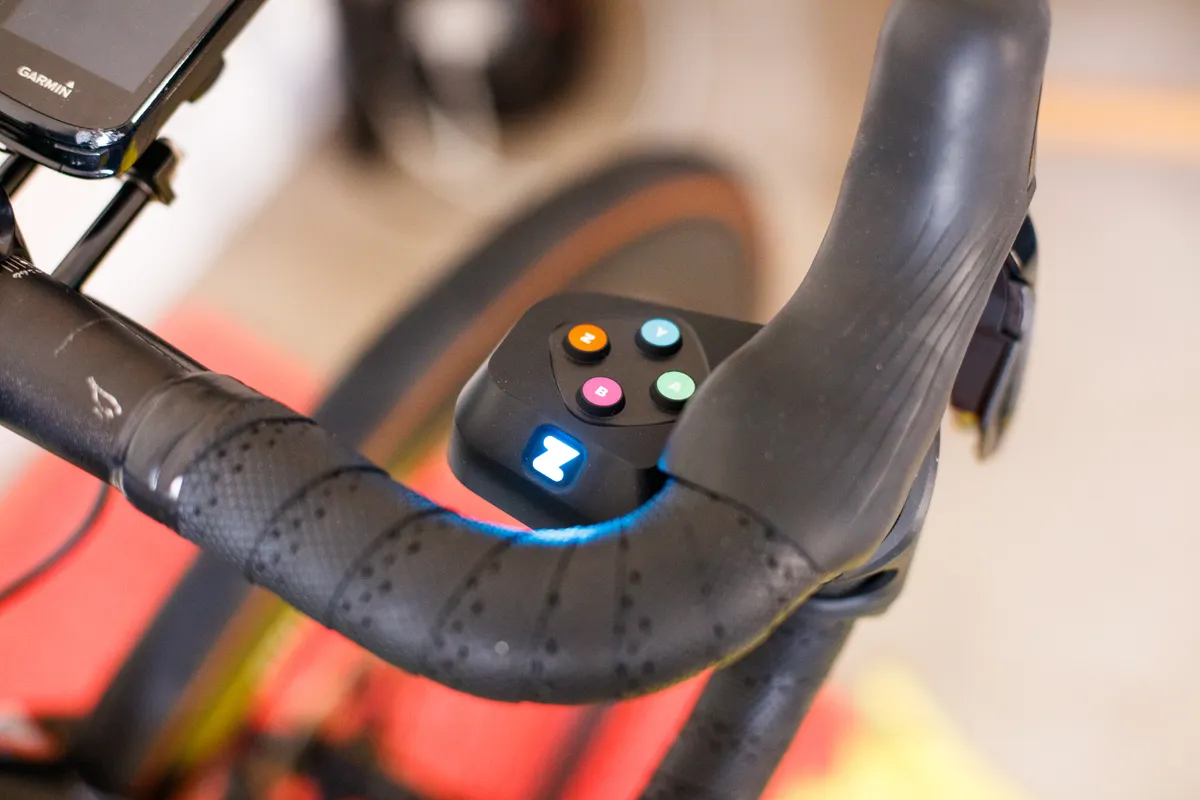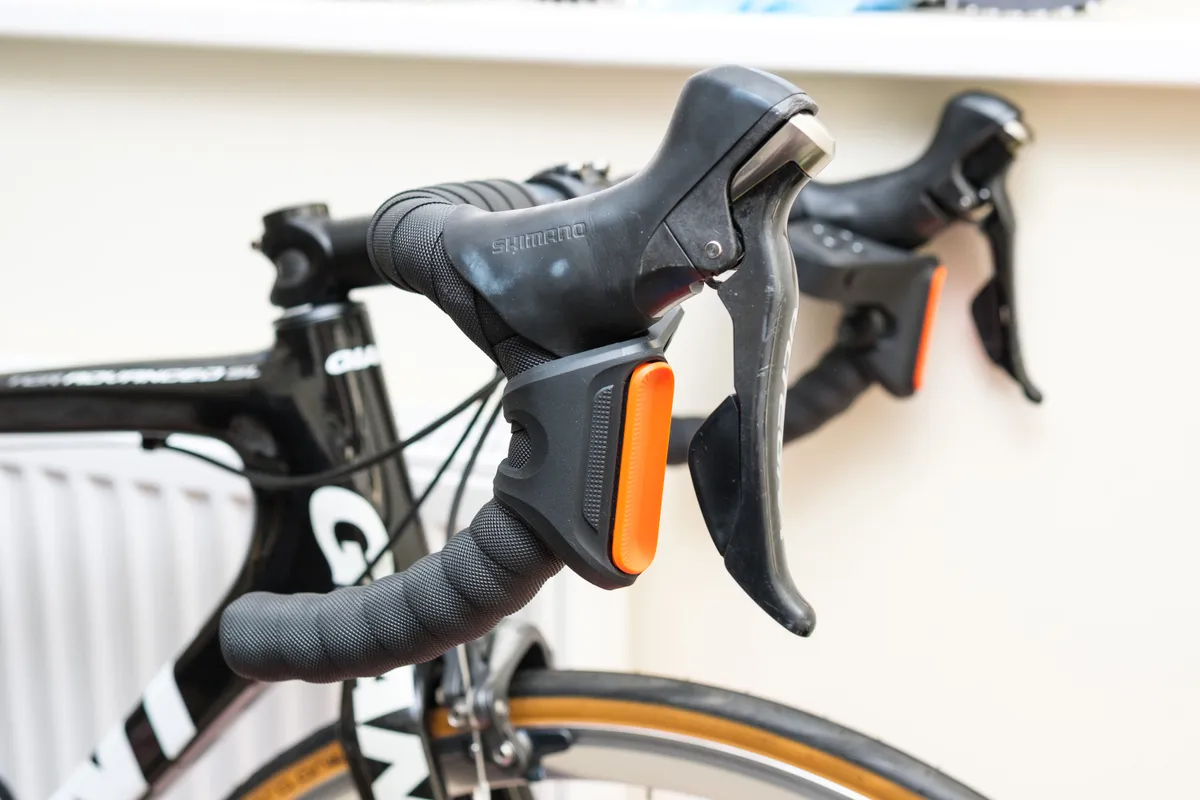Zwift Play is a controller system for the Zwift virtual indoor cycling app, designed to mount to your bike’s handlebars.
In use, the Play controllers significantly streamline the user experience on the Zwift app and offer clear performance advantages in Zwift races or group rides.
They aren’t perfect. A lack of in-game chat integration feels like a missed opportunity, and the combination of steering and braking on the same buttons can lead to accidental inputs.
However, with early issues surrounding the wireless connection seemingly now resolved, I reach for Zwift Play every time I use the Zwift app – provided I’m on a bike with a drop handlebar.
While it doesn’t yet feel like an essential indoor training accessory for Zwift users, it soon will if the app continues its development trajectory.
Zwift Play specification

As we explained in our news story at launch, Zwift Play is like a video game controller (or gamepad) split in two.
At £149 / $149 / €149 (or £99 / $99 / €99 during the initial beta period), Zwift Play isn’t cheap at face value.
As I’ll come on to later, though, there are mitigating factors behind this and it compares favourably to competitor devices when you consider its broad feature set.

Like most modern smart devices, the controllers charge via USB-C. Zwift includes a cable with a split head, so you can charge both controllers at the same time, from a single USB-A outlet.
Without Zwift Play, it’s vital to have a touchscreen or mouse nearby to operate your smart device and interact with the app.
With Zwift Play, you can control almost everything the game offers without taking your hands off the handlebar.

The left controller features four directional buttons, closely spaced like a D-pad (Up, down, left and right), while the right controller has four action buttons (Y, A, B and Z) arranged in a diamond pattern.
Each controller then has a button (LS and RS) on the drop section, which can be used to control intensity in ERG mode workouts or to shift the Zwift Hub’s virtual drivetrain, and a tiltable, press-sensitive paddle (ZL and ZR) used to steer and brake.
With these, you can navigate menus, select routes, join rides, control your avatar while riding, use power-ups and so on.

Zwift Play controllers can also be used to take advantage of the virtual drivetrain on the Zwift Hub and Zwift Hub One smart trainers.
It’s here Zwift Play comes into its own, because when using the controllers as virtual shiters you inevitably make far more frequent use of them.
No chit-chat

The only notable ‘control’ missing is one to use the in-game chat function.
As a reminder, while on the Zwift Companion app (available for iOS and Android devices), you can type or dictate text messages to send to anyone within 500 metres of your avatar. You can also send private messages to individual riders.
There’s no microphone integrated into the Zwift Play controllers to perform the speech-to-text function, or any option to connect one.
You can access the ‘group message’ prompt via the in-game action bar with Zwift Play, but you’ll still need a keyboard to type out your message.
As someone who rarely gets involved with in-game chat, this wasn’t an enormous personal loss.
However, having attended plenty of Zwift group rides, chat is something many riders are keen on. So keen, in fact, that some even use Discord (a third-party voice chat platform) to talk to each other during virtual group rides.
If you want to interact with fellow riders beyond sending emotes, then, you’ll still need a keyboard for typing out messages, or a secondary smart device running either the Zwift Companion app or a third-party platform.
Zwift Play build quality

Though still technically in a beta phase, the Zwift Play controllers feel every bit the finished article in hand.
The build quality is excellent, with high-quality materials used throughout. Everything feels solid and built to last.
While I’m not the sweatiest rider (perhaps because I have a large fan), I don’t have any concerns about its waterproof qualities, either. There are no clear weak spots in the build for water to ingress, provided the charge port covers are closed.
The rubber straps used to mount the controllers to your handlebars also feel impressively strong, which is good because they’re not replaceable.
Zwift Play handlebar compatibility

The controllers are shaped to mount to the drops of a standard road handlebar, using integrated rubber straps.
I tried them on a number of 31.8mm drop handlebars, with varying drop shapes and didn’t find any with which they didn’t get on.
They were a tight fit on a Pro Vibe Carbon handlebar with relatively thick handlebar tape, but stretching the rubber band to fit didn’t cause any damage.

The rubber bands come in a single, fixed size (and aren’t removable) so Zwift also includes spacers to take up any slack when using old-school, 25.4mm drop bars.
As Zwift acknowledges, the Play controllers aren’t designed to work with other types of handlebars, whether that’s flat bars on a mountain or hybrid bike, or base bars or aero extensions on time trial or triathlon bikes.
Although they may physically fit to these bars, the controls will likely end up in an odd place because the Play controllers are intended to mount vertically, not horizontally.

I was able to mount them to the base bar on my Planet X Exocet II time trial bike, for example, but the D-pad and action buttons ended up facing away from the saddle.
The controls for steering and virtual shifting, or ERG mode intensity, were still usable like this, but accessing the other buttons was understandably awkward.
Zwift Play connectivity

Zwift Play uses Bluetooth to connect to whatever smart device you have running Zwift.
Alternatively, you can connect to a smartphone running the Zwift Companion app as a bridge. This can be useful if you’re playing Zwift on a device with limited connectivity slots, such as an Apple TV box (which can only accommodate three BLE connections, including its own remote).
As reported in my first ride review of Zwift Play, my initial experience with the controllers was plagued by constant connection drops.
Having been in a busy room at Zwift’s London HQ, with multiple people using wireless devices, I put this down to signal interference and teething issues with the beta software.
Unfortunately, when I got a set at home in September, I experienced the same issues. The Bluetooth connection would drop frequently, despite the controllers being only a metre away from my laptop (an Apple MacBook Pro).

It’s fair to say my indoor training setup is fairly ‘noisy’, in terms of the quantity of wireless signals. However, even a set of cheap Bluetooth headphones managed to hold a stable connection in the same conditions, so signal interference alone didn’t seem to explain the issue.
At this point, I was rueing the fact Zwift doesn’t allow wired connections via the USB-C charging port. It seemed an obvious solution to an otherwise deal-breaking problem.
Fortunately, around the beginning of October, with updates to the firmware of the Zwift Play controllers and the game itself, this connection issue was resolved.

Since then, I’ve used the Play controllers solidly for a month with only one or two connection drops.
I’m now content to rely on them for virtual races, workouts and the like.
Thankfully, if the connection is dropped, pressing any button prompts them to connect automatically to the Zwift app – you don’t need to re-open the device pairing screen every time.
Zwift Play performance
Zwift Play ergonomics and virtual shifting

The location of the controllers requires you to shift your hands backwards slightly from where they’d naturally rest on your brake hoods (assuming your bike fit is roughly correct).
As noted in my first ride review, I got used to this and it’s far more convenient than needing to reach for a mouse, keyboard or other device to control the game.
The D-pad and action buttons require more effort to depress than a standard video game controller, which helps prevent accidental inputs.
In contrast, though, the travel and click feel of the shift/intensity control buttons is softer and less distinct. It’s not as obvious that you’ve properly pressed the button as with the shifter paddles found on mainstream electronic groupsets, such as Shimano Di2 or SRAM AXS, for example.

When riding while wearing headphones (and listening to the BikeRadar podcast, of course), I found I couldn’t hear the soft ‘click’ when pressing it either.
Of course, on a flat virtual road, you’d always feel the change in resistance at the pedals when shifting a virtual gear, which operates as another form of feedback. However, on changeable terrain, it’s not always immediately obvious whether you’ve shifted a virtual gear or the virtual gradient has changed.
Consequently, I often found myself looking to the in-game gear counter on the HUD (Heads Up Display) to confirm something had happened.
Ideally, I’d have preferred these buttons to have a little more travel and clearer tactile feedback indicating they’d been successfully pressed.

Using Zwift Click as a sprint shifter
With your hands on the drops, the shift/intensity control buttons are also a little too close to the bar to be operated comfortably with your fingers while sprinting.
When using Zwift Play to shift the Hub One’s virtual drivetrain, I therefore found it useful to position the Zwift Click shifter (which comes with the Zwift Hub One, or a Zwift Cog purchased as an upgrade for the original Zwift Hub smart trainer) as a kind of sprint/satellite shifter.
I found it worked best when positioned on the inside of the right handlebar drop, where I could operate it with my thumb while holding the drops.

Zwift Play steering and braking
On the whole, the tiltable paddles are great for steering. It feels far more natural than turning your handlebar to steer as needed with the Elite Sterzo Smart (which I’ve had since it launched but rarely use, because it feels unintuitive to aggressively turn the handlebar to steer on a road bike).
When trying the Repack Rush tech demo (a time-trial course featuring hazards and boost pads) at Zwift HQ, I initially felt the steering logic seemed a bit unnatural.
Where most racing video games require you to be in constant control of your avatar, Zwift steering works on the basis of moving you between invisible lanes on the road. This means you won’t simply ride off the road if you don’t steer round a corner.
When riding in Zwift’s less gamified worlds, this felt much better, however. With nothing specific to ‘hit’ or avoid (such as boost pads or hazards), the regression to a lane whenever you stop tilting a paddle didn’t feel as intrusive.

It also means you can forget about steering when really going for it and let the automatic steering take control of your avatar.
The ability to steer also offers clear performance advantages in group rides, races or timed events.
Taking a ‘racing line’ through corners means you can easily shave seconds off lap times, or move up the virtual bunch without any extra effort. You can also optimise your position in the virtual draft of the bunch or other riders, to ensure you’re always getting the maximum possible benefit.

The only thing I don’t love about the steering paddles is they do double duty as virtual brake levers (each paddle can be tilted outwards to steer and inwards to brake). This makes it possible to accidentally brake when you're meaning to steer.
It didn’t happen frequently, but early in testing I got momentarily dropped from a group ride when I unintentionally nudged a paddle the wrong way and braked. I then had to expend extra energy to get back into the bunch.
Had I been on my physical limit – during a tough race or event, for example – it’s possible I could have been dropped for good.
Given there’s nothing to be gained by braking in Zwift as things stand (you can zoom through corners at full speed currently), there’s only something to lose with accidental inputs such as this.
Presumably, Zwift intends to change this at some point and give riders a good reason to brake (otherwise, there’d be no point including it as a core function on the controllers), but until then, I’d like an option to switch it off.
Zwift Play pricing and value

The full RRP for Zwift Play is £149 / $149 / €149, but the controllers are currently on sale for £99 / $99 / €99 during the beta period (at the time of writing, Zwift said it didn’t have a confirmed date for when this beta period will end, because it is still “testing new game features connected to Play”).
On paper, the full RRP seems pricey compared to first-party games console controllers from the big three manufacturers (Nintendo, Microsoft and Sony), all of which are available for around £55 to £65.
Considering the economies of scale for those three companies are vastly different from Zwift’s, though, and that Zwift Play has been designed from the ground up for an entirely new application, it’s easy to appreciate why the cost is so much higher.
Considering Wahoo’s (now discontinued) Kickr Steer device – which contained no electronics and required a smartphone to make use of its only function (steering in the now defunct Wahoo RGT) – cost £89.99 / $99, and Elite’s Sterzo Smart steering plate costs £74.99, Zwift Play’s price doesn’t seem unreasonable given its considerably greater functionality.
Zwift Play bottom line

Zwift Play is an impressive first effort at creating a true video-game style controller for an indoor cycling app.
It isn’t perfect or cheap, but, as promised, Zwift Play makes interacting with the Zwift app a much smoother experience.
Unsurprisingly, the controllers shine brightest when used with Zwift’s own smart trainer, the Hub and its virtual drivetrain capabilities.
However, I still found it a useful tool when using other smart trainers, such as an Elite Direto XR or the Wahoo Kickr Move. Its slick implementation of steering provides tangible advantages in virtual races or group rides.
Perhaps most interestingly, Zwift Play is a clear statement of intent from Zwift about the direction in which its game is heading.
While the Play controllers don’t feel like an essential accessory as things stand, that could change soon if updates to the game integrate more of its core functions more comprehensively.
Product
| Brand | Zwift |
| Price | €149.00, £149.00, $149.00 |
| Weight | 220g |
Features
| Connectivity | bluetooth |
| Device compatibility | android |
| Device compatibility | ios |
| Device compatibility | mac |
| Device compatibility | windows |
